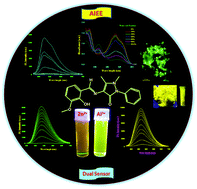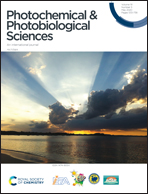An antipyrine based fluorescent probe for distinct detection of Al3+ and Zn2+ and its AIEE behaviour†
Abstract
A simple antipyrine based fluorescent probe, 4-[(2-hydroxy-3-methoxy-benzylidene)-amino]-1,5-dimethyl-2-phenyl-1,2-dihydro-pyrazol-3-one (OVAP), has been successfully synthesized using a one-step condensation method. It exhibits dual sensing properties toward Al3+ and Zn2+ in the presence of other relevant metal ions and also displays novel aggregation induced emission enhancement (AIEE) characteristics in its aggregated/solid state. Aggregated OVAP microstructures with interesting morphologies have been synthesized using SDS as a morphology directing agent. Morphologies of the particles are characterized using optical microscopy. Photophysical properties of the as-synthesized OVAP hydrosol are studied using UV–Vis absorption, steady state and time resolved fluorescence spectroscopy. The ‘turn on’ luminescence property of OVAP is used for the selective detection of trace amounts of Al3+ and Zn2+ and a significant turn on fluorescence enhancement over ∼100-fold is triggered via chelation-enhanced fluorescence (CHEF) through complex formation. The 1 : 1 stoichiometry of each sensor metal ion complex is observed from Job's plot based on UV-Vis absorption titration. The LODs for Al3+ and Zn2+ are found to be 1.05 nM and 2.35 nM, respectively. Notably, the sensor, OVAP, is further demonstrated using a molecular INHIBIT logic gate.



 Please wait while we load your content...
Please wait while we load your content...